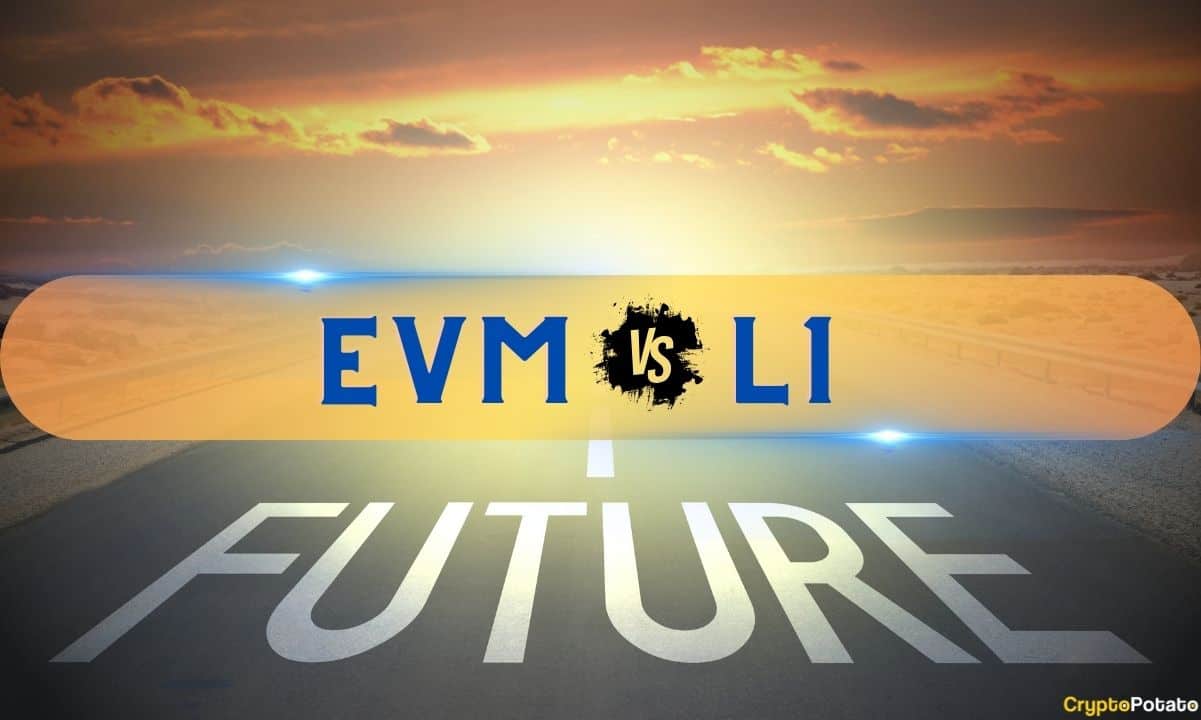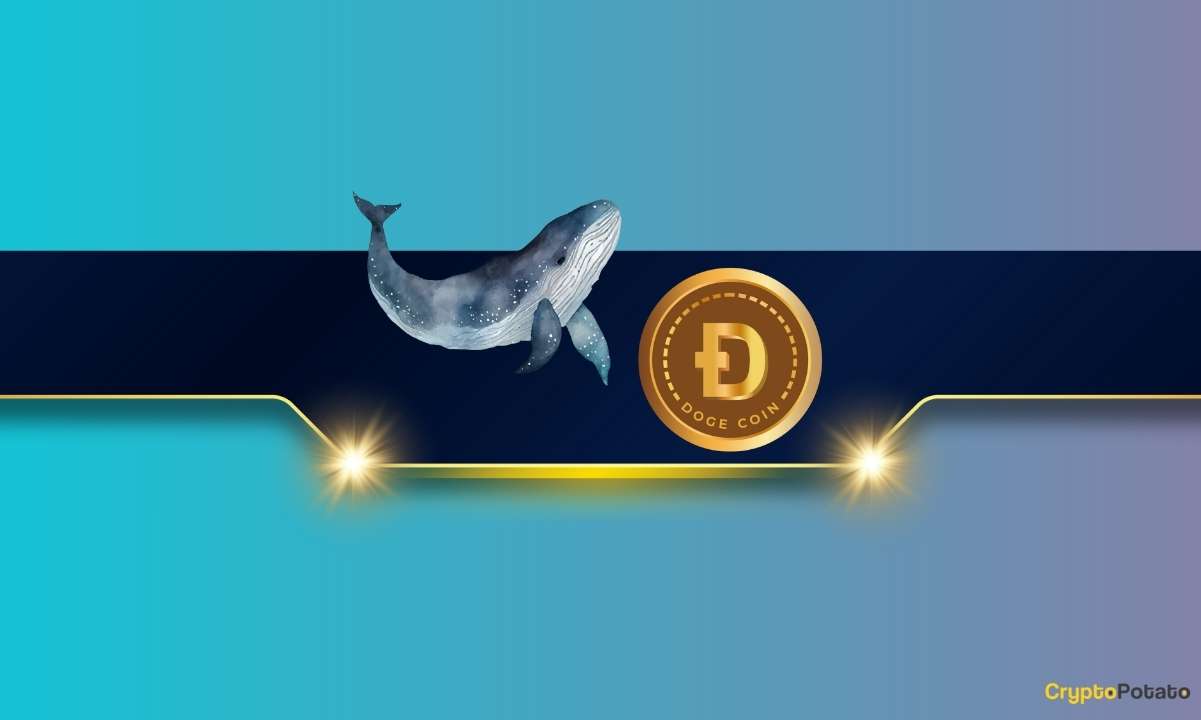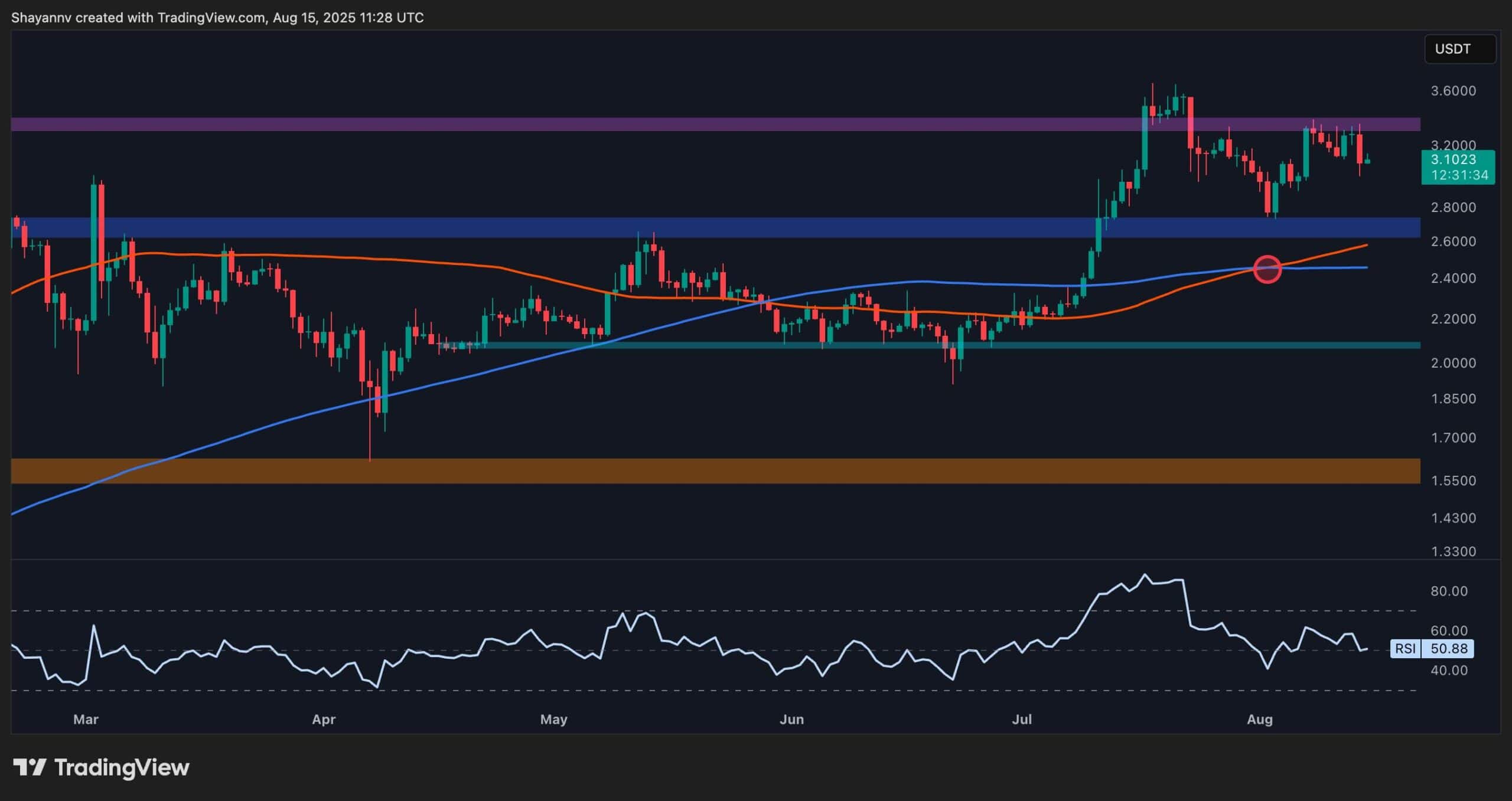Cryptocurrency
The Rivalry Between EVM and L1s Will Shape the Future of DeFi (Opinion)

By Piers Ridyard, CEO of RDX Works
The 2018-19 bear market saw the development of the MetaMask wallet, Uniswap decentralized exchange, OpenSea NFT marketplace, and alternative Layer 1s such as Solana. Only with this kind of core infrastructure in place was the subsequent 2021 boom in DeFi and NFTs made possible.
A similar story is playing out today. Emerging from the rubble are two competing visions vying to become the core infrastructure of the next cycle:
The incumbent Ethereum and its ecosystem of Layer 2 (L2) scaling networks, such as Arbitrum and Polygon that run the Ethereum Virtual Machine (EVM).
A new cohort of Layer 1s (L1s) have purposefully avoided the EVM and aim for an enhanced wallet user experience, application development environment, and scalability, with networks such as Aptos, Radix, and Sui being the prime examples.
EVM Layer 2s: Scaling The Incumbent
The EVM is the dominant platform in Web3 today, accounting for ~95% of all DeFi assets under management (AUM), ~80% of active addresses, and ~40% of all Web3 developers.
This success has led to Ethereum’s congestion and high transaction fees. The almost universally accepted solution: L2 scaling networks.
L2s are separate networks, offering their own ledger, tokens, and decentralized applications (dApps.) Their defining feature is that they periodically post summaries of their transactions back to the L1, Ethereum, piggybacking on the L1 to guarantee that transactions won’t roll back.
These L2s offer the same application development environment as Ethereum, the EVM. This allows for any dApp built on Ethereum to be easily copied over to an L2. From DEXes to lending to NFTs, dApps copied over can benefit from a new network that has higher throughput and lower fees yet inherits some of the security of Ethereum itself.
But there are issues with this approach.
First, security and developer experience continues to be a major concern. From the original hack of The DAO in 2016 through the billions of dollars lost annually over 2021-2022, the EVM has proven time and again that dApps built with it cannot safeguard users’ funds.
Second, the UX is far from mainstream-ready. The EVM places a high technical burden on its users, including “blind signing” – equivalent to signing a blank check for every transaction; “seed phrases” – a password that must be kept secure, else you may lose all your assets; or the need to be wary of “malicious tokens” that could steal your assets.
The requirement to maintain backward compatibility means solutions tend to be additive, piling up more complexity and risk rather than making the deep-rooted changes needed to fix issues properly. A case in point, ERC-4337 Account Abstraction, which is Ethereum’s solution to seed phrases, proposes an entirely new “mempool” through which transactions must be routed.
Third, L2s only half-solve the problem of scalability as each new network is like a new island with its own dApps and liquidity, not “composable” with the Ethereum mainland or other L2s. For this reason, we shall continue to see projects prioritize being on Ethereum, or in the scenario that an L2 gains enough traction to provide a compelling alternative, it will ultimately itself become congested, taking us back to square one.
Non-EVM L1s: The Challengers
Rather than iterate on the EVM, a new batch of L1s are charting their own path, starting from scratch with their own custom stacks.
First, they differentiate by addressing the neverending hacks and exploits through an improved developer experience. To achieve this, some projects, for example, have turned smart contracts containing assets into physical objects that can be “moved” between owners, with features to improve the security of tokens and smart contracts.
At the same time, other protocols have taken the object model one step further, with all assets being natively governed by a “DeFi Engine.” Similar to how Game Engines reduced bugs and improved game developer productivity by natively governing behaviors such as physics and gravity, this same concept is now being applied to finance.
In fact, assets being native to the ledger isn’t just a benefit for developers. It is a prerequisite to an improved user experience. By natively understanding assets, these platforms can provide users with human-readable transactions that guarantee what the transaction is going to do.
This solves the blank check “blind signing” transactions that the EVM and its L2s are architecturally unable to fix, as they can’t offer guarantees on something they don’t natively understand.
On the subject of scalability (the very problem that L2s were built to solve), new approaches promise to offer “linear scalability” without compromising that all-important composability.
This includes “intra-validator sharding,” which allows for each computer that validates transactions to actually be composed of many different underlying computers, or “multi-shard consensus.”
This allows for parallelization of processing across multiple groupings of computers. In each of these cases, adding more computers to the network allows for more transactions to be processed, similar to how the internet itself scales.
The Fight Ahead
Despite the technical advantages offered by the latest L1s, decentralized networks are all about community and momentum. The EVM and its L2s hold a significant lead in public awareness, developer community, and general tooling and infrastructure.
Getting developers to learn a new language and for users to adopt a new chain amongst all the noise is not easy and depends on how well the value proposition of that new chain can be propagated.
But, taking a step back – DeFi and Web3 account for only 0.01% of global financial assets, 0.1% of internet users, and 0.1% of global developers. The journey ahead is long, and there is still ample opportunity for newer platforms with radically different approaches and significantly less technical debt to fight for the remaining 99.9%.
Author bio
Piers Ridyard is the CEO of RDX Works, a public protocol and ledger for DeFi. Piers started in crypto when he started mining on the genesis block of Ethereum in early 2015, investing in “The DAO” and going deep on everything from game theory to prediction markets. This eventually led him to build and exit Surematics, a YCombinator company that built decentralized dealroom software for insurance companies in 2017. Piers became CEO of RDX Works in 2017, joining the Founder, Dan Hughes, and building the team to over 75 people around the world. His background includes finance, law, electronics, and mathematics. He also has two degrees, one in Chinese and Business and a second in Law, as well as having achieved his level 1 Chartered Financial Analyst designation.
Binance Free $100 (Exclusive): Use this link to register and receive $100 free and 10% off fees on Binance Futures first month (terms).
Cryptocurrency
Ethereum Foundation, Whales, and Hackers: What’s Driving the ETH Sell-Off?

TL;DR
- Whales, hackers, and the Ethereum Foundation wallets moved over $500M in ETH through large sales and withdrawals.
- Ethereum transfers rose to 4.6M ETH, nearing the monthly high of 5.2M recorded in July.
- Staking inflows hit 247,900 ETH, the highest in a month, locking more supply from trading.
Large Withdrawals and Whale Activity
Ethereum (ETH) has seen heavy movement from major wallets over the past few days. On-chain data from Lookonchain shows a newly created wallet pulled 17,591 ETH, worth $81.62 million, from Kraken in just two hours.
Over three days, two new wallets withdrew a combined 71,025 ETH, valued at $330 million, from the exchange.
One of these wallets, address 0x2A92, has withdrawn 53,434 ETH, worth $242.34 million, in two days. This includes a recent purchase of 30,069 ETH, valued at $138.46 million, during a market drop.
Major ETH Holders Offload Millions Amid Price Rally
In contrast, several separate entities have been disposing of some ETH holdings. A wallet tied to a hacker address 0x17E0 sold 4,958 ETH for $22.13 million at $4,463, securing a profit of $9.75 million. Earlier this year, the same address sold 12,282 ETH at $1,932 and later bought back part of the amount at higher prices.
A different whale sold 20,600 ETH for $96.55 million over the past two days, generating a profit of more than $26 million after holding the position for nine months.
Meanwhile, an Ethereum Foundation-linked wallet, 0xF39d, sold 6,194 ETH worth $28.36 million in the last three days at an average price of $4,578.
Recent sales from the same wallet included an additional 1,100 ETH and 1,695 ETH for over $12.7 million combined.
The #EthereumFoundation-linked wallet(0xF39d) sold another 1,300 $ETH($5.87M) at $4,518 ~11 hours ago.
Over the past 3 days, this wallet has sold a total of 6,194 $ETH($28.36M) at an average price of $4,578.https://t.co/4hfCWymHVG pic.twitter.com/ErUyEY8SJy
— Lookonchain (@lookonchain) August 15, 2025
Network Activity on the Rise
CryptoQuant data shows Ethereum’s total tokens transferred have been climbing since August 9. After ranging between 1 million and 3 million ETH through late July and early August, transfers have risen to 4.6 million ETH, approaching the monthly high of 5.2 million recorded in mid-July. This increase has occurred alongside a price rally from about $3,400 to $4,600.
Interestingly, staking inflows generally stayed between 20,000 and 80,000 ETH per day over the past month. On August 14, inflows jumped to 247,900 ETH, the highest in the period.
At the time, ETH was trading near $4,600. Large staking deposits reduce the amount of ETH available for immediate trading, as staked coins are locked for a set period.
In the meantime, ETH trades at $4,647 with a 24-hour volume of $68.25 billion, down 2% on the day but up 19% over the week.
Binance Free $600 (CryptoPotato Exclusive): Use this link to register a new account and receive $600 exclusive welcome offer on Binance (full details).
LIMITED OFFER for CryptoPotato readers at Bybit: Use this link to register and open a $500 FREE position on any coin!
Cryptocurrency
Massive DOGE Whale Activity Hints at $1 Breakout

TL;DR
- Whales bought two billion DOGE this week, lifting their combined holdings to 27.6 billion coins.
- A single 900M DOGE transfer worth $208M to Binance drew attention to large exchange movements.
- DOGE broke key resistance, with momentum building for a possible push toward the $1 price mark.
Price and Market Moves
Dogecoin (DOGE) traded at $0.23 at press time, slipping 4% over the past day but still showing a 2% gain for the week. Daily turnover came in at about $6.18 billion.
Meanwhile, the broader crypto market saw over $1 billion in liquidations. Hotter-than-expected US Producer Price Index data pushed traders to scale back expectations of a near-term Federal Reserve rate cut. DOGE had roughly 290,500 coins liquidated during the sell-off.
On the two-week chart, analyst Trader Tardigrade notes that DOGE has cleared a downward-sloping resistance line after completing what appears to be a “wave V” in an Elliott Wave sequence. Similar setups in the past, where prolonged declines stayed within falling channels before breaking higher, have been followed by sharp rallies.
$Doge/2-week#Dogecoin is gaining strong momentum to surge above $1 pic.twitter.com/TuSEKr19nv
— Trader Tardigrade (@TATrader_Alan) August 15, 2025
Momentum gauges are also turning up. The Stochastic RSI, which had dropped into oversold territory, is now heading higher. Previous reversals from this zone have coincided with sustained upward moves. The current formation points to a possible run that could carry DOGE past the $1 mark.
Heavy Whale Buying and Large Transfers
As reported by CryptoPotato, blockchain data shows large investors have added two billion DOGE in the past week, spending just under $500 million. That brings their holdings to about 27.6 billion coins, or 18% of the supply. The buying streak has prompted speculation within the community.
Recently, Whale Alert flagged a 900 million DOGE transfer worth about $208 million into Binance. The tracking indicates that it originated from a wallet connected to the exchange, likely as an internal activity. The address involved holds 2.88 billion DOGE, one of the largest balances on the network.
Ali Martinez also reports that transactions above $1 million reached a one-month high, with activity building since early August and peaking as DOGE traded at $0.25.
Whales are back! Dogecoin $DOGE activity at a 1-month high. pic.twitter.com/C83Pv68mCt
— Ali (@ali_charts) August 14, 2025
Sentiment Building
Analyst Gordon described the current setup as “a nice bit of consolidation” before a potential breakout, adding,
“This will be one of the first coins normies FLOCK to & the pump will be MASSIVE.”
With whale accumulation rising, high-value transfers increasing, and a bullish technical pattern in play, DOGE is positioned for a potential push toward $1 if momentum holds.
Binance Free $600 (CryptoPotato Exclusive): Use this link to register a new account and receive $600 exclusive welcome offer on Binance (full details).
LIMITED OFFER for CryptoPotato readers at Bybit: Use this link to register and open a $500 FREE position on any coin!
Cryptocurrency
Ripple Price Analysis: XRP at Risk as Key Support Levels Could Trigger Sharp Drop

XRP has recently entered a consolidation phase after a strong rally earlier this summer, with the price action now hovering around key resistance levels on both its USDT and BTC pairs. Yet, while momentum has slowed, the charts still indicate a generally bullish structure, with multiple key support levels remaining firmly in place.
Technical Analysis
By ShayanMarkets
The USDT Pair
On the XRP/USDT daily chart, the price is currently trading near the $3.10 mark, facing a strong resistance zone around $3.40. This follows a breakout above the $2.70 range in July, which has now flipped into a support area.
Both the 100-day and 200-day moving averages are also trending upward and recently formed a bullish crossover around $2.45, reinforcing the medium-term bullish sentiment. If the $3.40 resistance breaks, a push toward the critical $4.00 range becomes likely.
However, the RSI hovering near the neutral 50 level suggests a lack of strong momentum for now, meaning a short-term pullback into the $2.80 support zone is still possible.
This zone will be key for maintaining the bullish structure. Losing it could open the door for a deeper correction toward the 200-day moving average located around the $2.40 mark. Yet, as long as the price stays above the moving averages, the broader trend remains bullish.
The BTC Pair
Looking at the XRP/BTC chart, the pair has recently pulled back after hitting the 3,000 SAT resistance, with the price currently around 2,600 SAT.
This follows a clean breakout above the long-term descending channel and a successful retest of its upper boundary, which coincided with the 200-day moving average and the 2,400 SAT support zone. This confluence remains a key bullish technical factor, as holding above it could attract renewed buying pressure.
That said, RSI levels around 48 show that momentum has cooled after the sharp July rally, meaning XRP may continue ranging between 2,400 SAT and 3,000 SAT in the near term. A decisive close above 3,000 SAT would likely open the path to the 3,400 SAT zone, while losing 2,400 SAT could shift the bias back toward 2,000 SAT support. For now, the structure still favors the bulls as long as higher lows remain intact.
Binance Free $600 (CryptoPotato Exclusive): Use this link to register a new account and receive $600 exclusive welcome offer on Binance (full details).
LIMITED OFFER for CryptoPotato readers at Bybit: Use this link to register and open a $500 FREE position on any coin!
Disclaimer: Information found on CryptoPotato is those of writers quoted. It does not represent the opinions of CryptoPotato on whether to buy, sell, or hold any investments. You are advised to conduct your own research before making any investment decisions. Use provided information at your own risk. See Disclaimer for more information.
Cryptocurrency charts by TradingView.

 Forex3 years ago
Forex3 years agoForex Today: the dollar is gaining strength amid gloomy sentiment at the start of the Fed’s week

 Forex3 years ago
Forex3 years agoUnbiased review of Pocket Option broker

 Forex3 years ago
Forex3 years agoDollar to pound sterling exchange rate today: Pound plummeted to its lowest since 1985

 Forex3 years ago
Forex3 years agoHow is the Australian dollar doing today?

 Cryptocurrency3 years ago
Cryptocurrency3 years agoWhat happened in the crypto market – current events today

 World3 years ago
World3 years agoWhy are modern video games an art form?

 Commodities3 years ago
Commodities3 years agoCopper continues to fall in price on expectations of lower demand in China

 Economy3 years ago
Economy3 years agoCrude oil tankers double in price due to EU anti-Russian sanctions





















